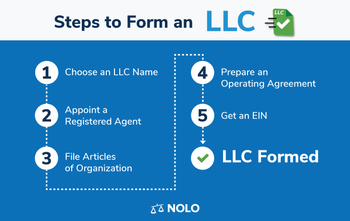
Starting a business is exciting, but it can also feel overwhelming when it comes to legal structures and paperwork. One of the most popular ways to structure a new company in the U.S. is by forming a Limited Liability Company, or LLC.
An LLC offers flexibility, protection, and credibility for small business owners and entrepreneurs. If you’re thinking about launching your own venture, here’s a simple breakdown of what an LLC is, why it matters, and how to create one.
What Is an LLC?
A Limited Liability Company (LLC) is a type of business structure that combines the flexibility of a sole proprietorship or partnership with the liability protection of a corporation.
In other words, if your business runs into debt or legal issues, your personal assets—like your home or car—are typically protected. That’s a major reason why so many small business owners choose to create an LLC.
Benefits of Creating an LLC
Before diving into the steps, it’s worth understanding why LLCs are such a popular option.
- Personal Liability Protection – Your personal and business finances stay separate.
- Tax Flexibility – LLCs can choose how they want to be taxed (sole proprietor, partnership, or corporation).
- Credibility – Having “LLC” after your business name often builds trust with customers and clients.
- Simplicity – LLCs usually involve less paperwork and fewer formalities compared to corporations.
For many entrepreneurs, an LLC strikes the right balance between protection and flexibility.
Steps to Create an LLC
While the process can vary slightly by state, here are the general steps you’ll need to follow:
1. Choose a Name for Your LLC
Your business name should be unique and not already registered by another company in your state. Most states have an online search tool to check name availability.
2. File Articles of Organization
This is the official paperwork that legally establishes your LLC with the state. It includes details like your company name, address, and the names of the owners (called “members”).
3. Designate a Registered Agent
A registered agent is someone who can receive legal documents on behalf of your LLC. This can be you, another member, or a professional service.
4. Create an Operating Agreement
Not always required, but highly recommended. This document outlines how your LLC will be run, including roles, responsibilities, and what happens if a member leaves.
5. Obtain an EIN (Employer Identification Number)
An EIN is like a Social Security number for your business. You’ll need it to open a bank account, hire employees, and file taxes.
6. Comply with Local Permits and Licenses
Depending on your industry and location, you may need additional permits to operate legally.
Common Mistakes to Avoid When Creating an LLC
While forming an LLC is usually straightforward, many first-time business owners make avoidable mistakes.
- Mixing personal and business finances → Always open a separate business bank account.
- Not filing annual reports → Some states require ongoing filings to keep your LLC in good standing.
- Forgetting about taxes → Even with flexibility, LLCs still have tax obligations you must plan for.
By avoiding these mistakes early, you’ll save yourself headaches later on.
Resources to Help You Get Started
Forming an LLC doesn’t have to be complicated. Many entrepreneurs use online resources to simplify the process. For example, CreateTuLLC provides guidance and services that walk you through each step so you don’t miss anything important.
Whether you decide to do it yourself or get professional assistance, the important thing is to set up your LLC correctly from the start.
Final Thoughts
Creating an LLC is one of the smartest moves you can make when launching a new business. It protects your personal assets, gives your company credibility, and offers the flexibility you need as your business grows.
While the process may seem intimidating at first, breaking it down into simple steps makes it much more manageable. Take the time to set up your LLC the right way, and you’ll have a strong foundation for success.






